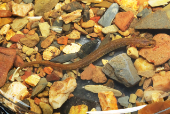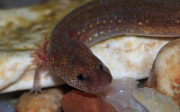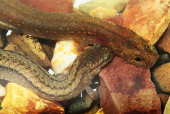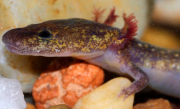Ouachita Streambed Salamander (Eurycea subfluvicola)
Description: In coloration, the dorsum of E. subfluvicola is primarily uniform with an amber/yellow background, pigmented with numerous dark brown melanophores, which create irregularly shaped blotches throughout its dorsum and flanks. In many specimens, irregularly spaced spots are formed by the absence of melanophores along the dorsolateral region of the trunk, possibly indicative of a lateral line. On the other hand, the semi-transparent venter is unpigmented, except for a few widely dispersed melanophores under the tail. The dorsal and ventral coloration is separated along the trunk by a sharply defined ventral-lateral boundary.
Habitat: The Ouachita Streambed Salamander is found in discrete sections of the Slunger Creek stream basin within secondary growth hardwood-pine forest. Streambed substrate is composed of clean, sediment free Arkansas novaculite gravels overlying the impervious Stanley Shale formation. Substrate composition and structure is critical to the survival of this semi-fossorial species. These salamanders engage in seasonal vertical movements from the subsurface to the surface and back again as water levels fluctuate due to seasonally intermittent surface flows. Sedimentation of the stream system would fill in the interstitial spaces between the novaculite gravels and prevent this seasonal movement to follow the water table of this fully aquatic species.
Range: Rare and endemic to AR: known only from one locality in the vicinity of Lake Catherine.
Found in these States:
AR
Diet: Aquatic isopods, aquatic oligochaete worms, and aphids have been identified as foods of this species.
Reproduction: In terms of reproduction, the species is paedomorphic, meaning they retain larval morphological characteristics (particularly external gills) into adulthood and, as such, are sexually mature adults. In males, testicular enlargement has been documented in February, reaching maximum size by summer months (late June and July) in the lab and corresponding to the mating season. In females, a maturing egg follicle has been observed in the field during late November, but in a more controlled laboratory setting, they matured through the summer. The species typically reaches full sexual maturity at lengths as short as 1.3 inches. Mature male snout-vent length (SVL) ranges from 1.4 to 1.8 inches, with female SVL not being noticeably different, ranging from 1.4 to 1.8 inches.
Status: The species is known only from the type locality stream basin within a small protected area and additional survey work is needed in the surrounding region in an effort to locate additional populations within the Ouachita Mountains. Since only one population is currently known, population size studies have not been conducted to avoid stress or mortality due to handling and marking. Major threats to this species are sedimentation of interstitial spaces in the streambed substrate and contaminants from fertilizer and/or other lawn chemical runoff from the surrounding area that could cause population declines within the reserve in the future, which could drive the species to Critically Endangered in a very short time. It is therefore listed as Vulnerable.
»» Kingdom: Animalia - Animals
»» Phylum: Chordata - Chordates
»» Subphylum: Vertebrata - Vertebrates
»» Class: Amphibia - (Amphibians)
»» Order: Caudata - Salamanders
»» Family: Plethodontidae - Lungless Salamanders
»» Genus: Eurycea
»» Species: Eurycea subfluvicola - Ouachita Streambed Salamander
This article uses material from the Wikipedia article "Eurycea subfluvicola", which is released under the Creative Commons Attribution-Share-Alike License 3.0. Content may have been omitted from the original, but no content has been changed or extended.
|












